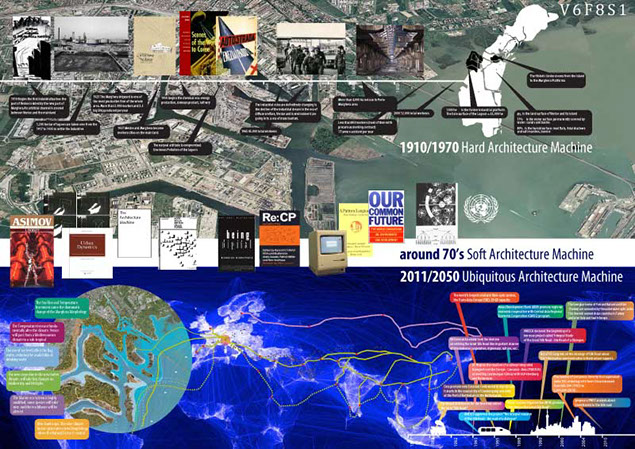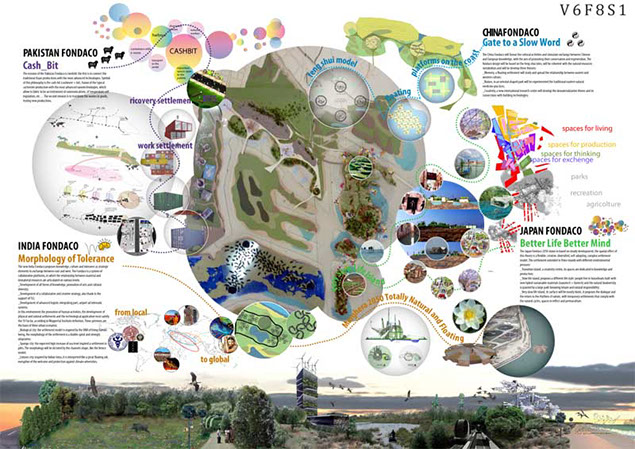
urbanism
a plaza for all
bio social housing
urban parks' system
angelopolis. new capital
highways landscape
strada vettore
venice great fondaco
strada nova
city hall square
east fondaci
highway's urban parks
urban street
po river landscaping
golf residence
green bypass
city hall square giavera
sustainable marinas
squares' system
landscape mitigation
Venice great fondaco
Type
Category
Year
Place
Team
Description
Competition
Architecture, Urban Planning
2011
Venice
Andrea Pennisi, Anna Omodeo, Giuseppe Longhi
Would be Venice an excellent node in the “ubiquitous cities” net?
Will be Venice able to transform its historical inability to adapt itself to technological progress into a beautiful handling of physical space, once a time?
The huge polluted Portomarghera spaces, full of “Hard Architectures” frames composed of sheds, big machineries, negative environmental and social externalities, are evidences of the Venice industrial history; a very different history from the well-known pre-industrial one.
According to Nicholas Negroponte, Portomarghera is an historical monument of a hard development irreparably beaten by the new rules of “Soft architecture machines”. These “Soft Architecture Machine”, at first complete the traditional physical and local instruments, and after replace them by means of immaterial, global, and interactive technologies; in a sequence where bits support atoms, starting a relentless run toward the dematerialization.
Today, cynic speculators, politics without scruple and accommodating archistarlet wish the ‘”rehabilitation” of this monument, in a melting-pot of greed, cultural poverty and social irresponsibility.
Our group propose a design strategy for Portomarghera rehabilitation oriented to responsible and sustainable development, based on the knowledge implementation and natural resources revaluation.
Knowledge implementation aims to increase human resources capability and wellbeing, by means of an internalization strategy of the exogenous forces shaking global world. It’s important to propose an inclusive design vision, based on the Venice connection with the new Euro-Asian cultural and economic fluxes, renewed thank to the re-opening of new silk road by rail, ship and high capability TLC, to reach this aim. The new role of Portmarghera historical territorial system is to become a metropolitan node of these new Euro-Asian relations. The rehabilitation process of these areas is a foundational moment of a new “Ubiquitous Venice”, connected in real time with any site all over the world. The social and physical model of the “Ubiquitous Venice” is inspired to the “Fondaco” historical typology, thought as a multidisciplinary and multifunctional platform, connected with the “cloud”. The fondaco organizational model is a non-hierarchical relation ecosystem, defined by:
_Hospitality, a model based on courtesy and capability to absorb and appropriate/assimilate the alien cultures, with the aim design potential innovation;
_Improvisation, relations based on feedback, adapting to the changes and easing the world exchanges;
_Bricolage, capability to observe and to reorganize people, knowledge, resources;
_Large scale, capability to work with great data base, to increase knowledge level, and with meta-filters, improving design quality.
Natural resources rehabilitation: handling natural resources aims to reduce design ecological footprint and to increase biodiversity, improving production of natural goods, and services, on land surface different from the present one: the one left over after raising of the sea level because of the Climate Change.
Driving forces of 2050 scenario are:
_New environmental conditions (clime, biodiversity, vegetal and animal species,.) produced by climate changes;
_The International Conventions about environment and human resources long time targets (2030-2050)

